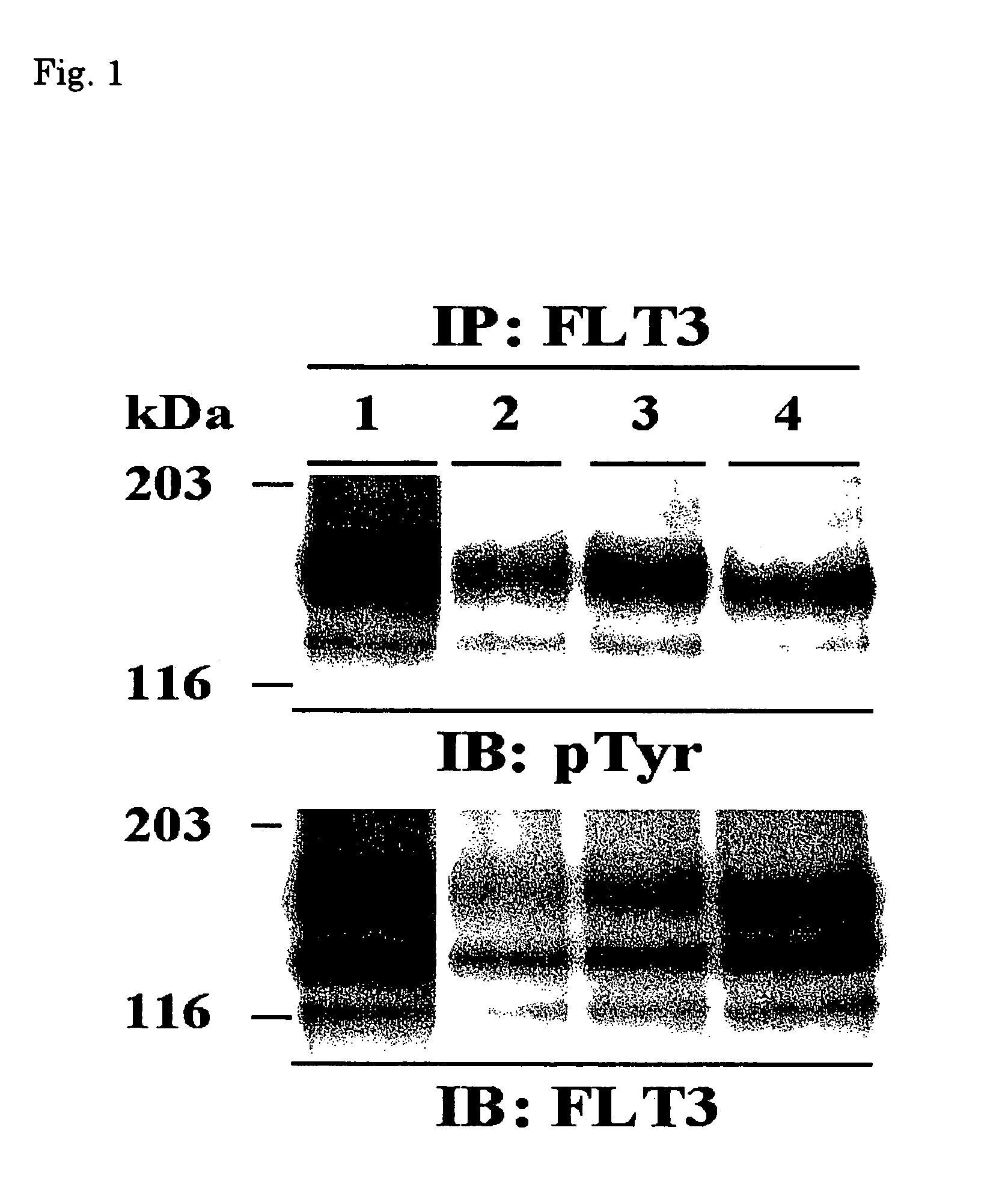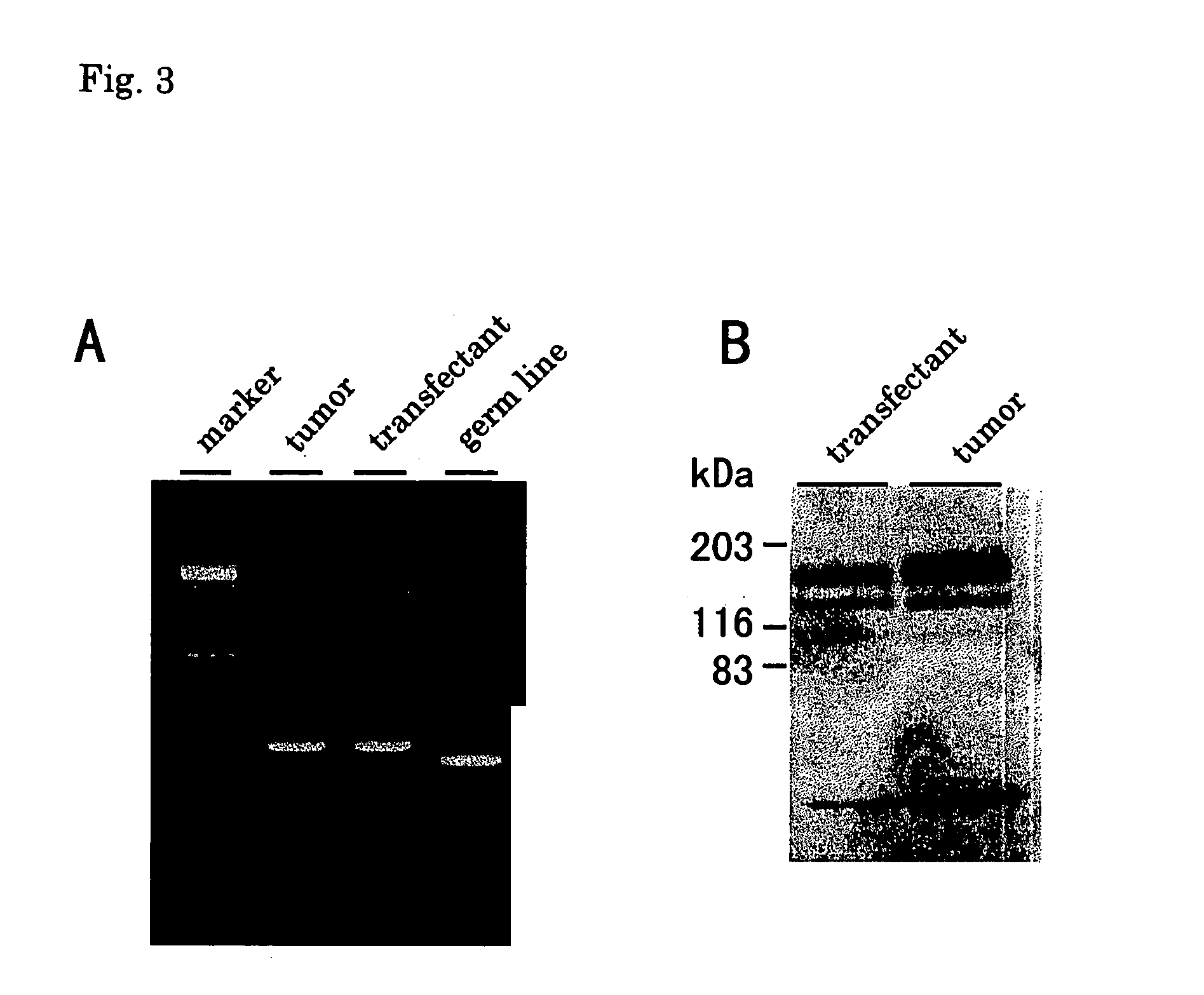Method and screening candidate compounds for drug against tumor
a candidate compound and tumor technology, applied in the field of tumor drug screening, can solve the problems of unfulfilled identification of mutations and mast cell leukemic cell lines
- Summary
- Abstract
- Description
- Claims
- Application Information
AI Technical Summary
Benefits of technology
Problems solved by technology
Method used
Image
Examples
example 1
Detection of FLT3 / ITD in Leukemia Cells
[0059]High molecular weight DNA was isolated from leukemia cells, and a DNA fragment containing the JM domain of the FLT3 protein was amplified by PCR according to the method described in Kiyoi, H., Leukemia 11: 1447–1452, 1997. The bands that differed from the band of the wild-type in size were excised from agarose gel and purified with Qiaex gel extraction kit (Qiagen), followed by cloning into pMOSBlue T vector (Amersham) according to the manufacturer's instruction. Ten colonies of the recombinants were cultured on the LB medium, and the plasmid DNA was prepared with QIAprep spin plasmid miniprep kit (QIAGEN). Nucleotide sequences of these clones were confirmed by sequencing. Expression of the FLT3 mRNA was confirmed by RT-PCR according to the method described in Kiyoi, H., Leukemia 11: 1447–1452, 1997. The bands that differed from the band of the wild type in size were cloned according to the method described above, and their nucleotide seq...
example 2
Introduction of an FLT3 / ITD Expression Vector into Blood Cells
[0063]Total RNA was extracted from leukemia cells and was used for cDNA synthesis. The cDNA synthesized was used as a template to amplify the MunI-EcoRV fragment, which contains the tandem repeat region found in mutants FTL3 cDNA, by RT-PCR. MunI-F primer (SEQ ID NO: 9 / 5′-CAACAATTGGTGTTTGTCTCCTCTT-3′) and EcRV-R primer (SEQ ID NO: 10 / 5′-CATGATATCTCGAGCCAATCCAAAG-3′) were used for the amplification. The amplified fragments were cleaved with MunI and EcoRV (Boehringer-Mannheim-Yamanouchi), resolved on agarose gel, and purified according to the aforementioned method. Expression vector pCDHF3 (a gift from Dr. Olivier Rosnet), which carries a full-length wild type FLT3 cDNA (Rosnet, O. et al., Blood 82:1110–1119; Accession No. S64785), was cleaved with MunI and EcoRV, and the purified FLT3 / ITD fragment was inserted into the vector. Four mutants of FLT3 / ITD (Mt1, Mt2, Mt3 and Mt4) were used. Nucleotide sequences of the mutated ...
example 3
Tyrosine-Phosphorylation of the FLT3 Molecules in the Transfectants
[0066](1) The transfectants were cultured in RPMI 1640 medium supplemented with 10% FCS (GIBCO), and then centrifuged at 1000 rpm for 5 minutes to recover 2×107 cells. The cell pellets were washed with PBS, dissolved in lysis buffer (20 mM Tris-HCl, pH 7.5, 150 mM NaCl, 2 mM EDTA, Nonidet P-40, 50 mM NaF, 10 mg / ml aprotinin, 10 mg / ml leupeptin, 1 mM Na3VO4, 50 mM Na2MoO4, 1 mM phenylmethylsulfonyl fluoride (PMSF)), allowed to stand for 1 hour at 4° C., then centrifuged at 15000 rpm for 30 minutes. Rabbit anti-human FLT3 antibody (Santa Cruz Biotechnology, Santa Cruz, Calif., USA) was added to the supernatants and the mixture was stirred for 2 hours at 4° C. After adding Protein A / G Plus agarose (Santa Cruz), the resulting mixture was stirred for 2 hours at 4° C. and washed with the lysis buffer three times. The pellets were then dissolved in sample loading buffer (0.125 M Tris-HCl, pH 6.8, 10% 2-mercaptoethanol, 4% S...
PUM
| Property | Measurement | Unit |
|---|---|---|
| pH | aaaaa | aaaaa |
| pH | aaaaa | aaaaa |
| length | aaaaa | aaaaa |
Abstract
Description
Claims
Application Information
 Login to View More
Login to View More - R&D
- Intellectual Property
- Life Sciences
- Materials
- Tech Scout
- Unparalleled Data Quality
- Higher Quality Content
- 60% Fewer Hallucinations
Browse by: Latest US Patents, China's latest patents, Technical Efficacy Thesaurus, Application Domain, Technology Topic, Popular Technical Reports.
© 2025 PatSnap. All rights reserved.Legal|Privacy policy|Modern Slavery Act Transparency Statement|Sitemap|About US| Contact US: help@patsnap.com



